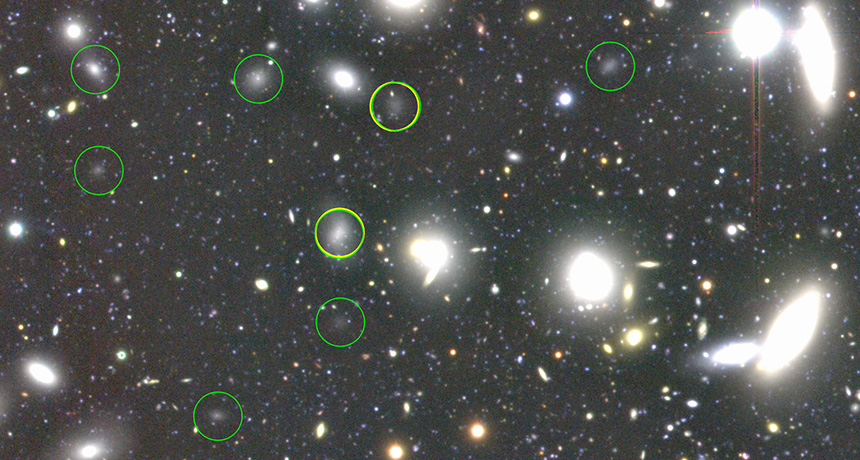Dark galaxies grow in abundance
Hundreds more shadowy, nearly starless suspects found in Coma cluster

GALAXY QUEST Eight dark galaxies (circled) are among more than 800 that lurk in a tiny part of the Coma cluster (pictured). The two circled in yellow were discovered in an earlier study.
NAOJ
- More than 2 years ago
Hundreds of shady characters are lurking in a nearby neighborhood of galaxies. The Coma cluster houses nearly 20 times as many dark galaxies as previously known, researchers report. These shadowy figures — some of which are as large as the Milky Way but with just one-thousandth the number of stars — could be dead ends in galactic evolution.
The cluster houses at least 854 of these barely perceptible galaxies, and there could be well over 1,000. These “ultradiffuse galaxies” appear to have had much of their star-forming gas stolen, Jin Koda, an astronomer at Stony Brook University in New York, and colleagues report. The findings appear online June 24 in Astrophysical Journal Letters.
Last year, another team of astronomers turned up 47 ultradiffuse galaxies in the Coma cluster (SN: 12/13/14, p. 9), a bevy of thousands of galaxies that sits roughly 330 million light-years away in the constellation Coma Berenices. Koda and colleagues wondered if a bigger telescope could find even more of these dark galaxies, so they dug through old images of the cluster taken by the 8-meter-wide Subaru telescope in Hawaii.
“It’s a beautiful result,” says Pieter van Dokkum, the astronomer at Yale University who led the discovery of the first 47 dark galaxies. “It’s very impressive.”
These galaxies are all relics from an earlier time. They haven’t formed any new stars in the last 4 billion to 10 billion years, Koda says. The galaxies aren’t scattered around the cluster haphazardly, as would be expected if they were new arrivals falling into Coma randomly. They are instead arranged symmetrically around the heart of the cluster, which indicates that they have been lurking within Coma for a very long time.
Their longevity is surprising. Star-starved galaxies are gravitationally tugged to and fro by their brighter and more massive brethren. With so few stars, the dark galaxies should have been torn apart long ago. “For these fluffy looking galaxies to survive, they need something like dark matter protecting them,” says Koda.
All galaxies are held together by dark matter, elusive particles that neither emit nor absorb light, revealing themselves only by their gravitational influence. These murky galaxies, however, take it to an extreme. To survive the rough and tumble streets of Coma, the dark galaxies must be over 99 percent dark matter, a far cry from the roughly 85 percent that’s typical of galaxies throughout the universe.
“These things were not expected to be there,” van Dokkum says. “We don’t quite know what they’ll tell us.” They could be failed galaxies that once were on their way to becoming like the Milky Way, he says. Something in the cluster might have stripped the galaxies of their gas, leaving behind a smattering of stars and a massive storehouse of dark matter.
One way to sweep out the gas, Koda says, is with a wave of supernova explosions. If enough stars exploded in a short enough period of time, perhaps they could have launched all the spare gas out of the galaxy. “But we don’t really know if that’s possible,” he says.
The finding also raises questions about what the limits are to being a galaxy, van Dokkum says. This horde of nearly 1,000 dark galaxies might be just the tip of the iceberg. “There could be a lot of galaxies out there that we’re still missing,” he says.







